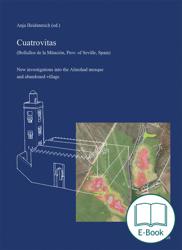The publication presents an investigation into rural settlement archeology in the hinterland of Almohad Seville. Many available methods from different disciplines were used for illustrating the past of Cuatrovitas. The informations are combined with 300 very explanatory figures and the entire documentation of the archaeological trenches.
The Islamic desert of Cuatrovitas is a case study of the planned expansion of a rural settlement including the construction of a mosque under the Almohads, and its survival under Christian rule. In a cooperative project between the universities of Bamberg, Huelva and Seville, the medieval reality of life away from the nearby capital Seville was reconstructed using interdisciplinary research methods. From an archaeological-historical perspective, the publication offers a wide range of exemplary information not only for the study site itself, but also for the surrounding cultural area of the so-called El Aljarafe.
Anja Heidenreich studied medieval and modern archaeology, European ethnology and Islamic art and archeology in Bamberg and Berlin. Her publications cover historical-archaeological topics from sites in Germany, Spain, Syria and Iran. She has been teaching at the Chair of Islamic Art History and Archeology of The Bamberg University for many years and is primarily concerned with archaeological materials and investigations on the medieval history of Islamic Spain.
The series Studies in Islamic Art and Archaeology Studien zur islamischen Kunst und Archäologie provides a fore for monograph studies of research in art history, in material and visual culture and in the archaeology of Islamic countries. The series is interested in new scholarship that presents architecture, objects, arts of the book, other visual media, and studies on excavations. While it emphasizes a plurality of methodological approaches and welcomes empirical and interpretive studies, the series is devoted to a high standard in presenting visual evidence. It also takes into account textual and epigraphic sources, transcultural reception and historiography. The series covers the early Islamic to the modern periods and ranges from the Western to the Eastern lands of Islamic culture. Contributions are devoted to individual objects, groups, or wider themes including thematic anthologies and conference proceedings. Publications in English or German are preferred, while other languages are possible, and each book offers an extensive English summary. The series is committed to a high quality in production and in the reproduction of colour and black-and-white images, and line drawings.


 Preface
Preface